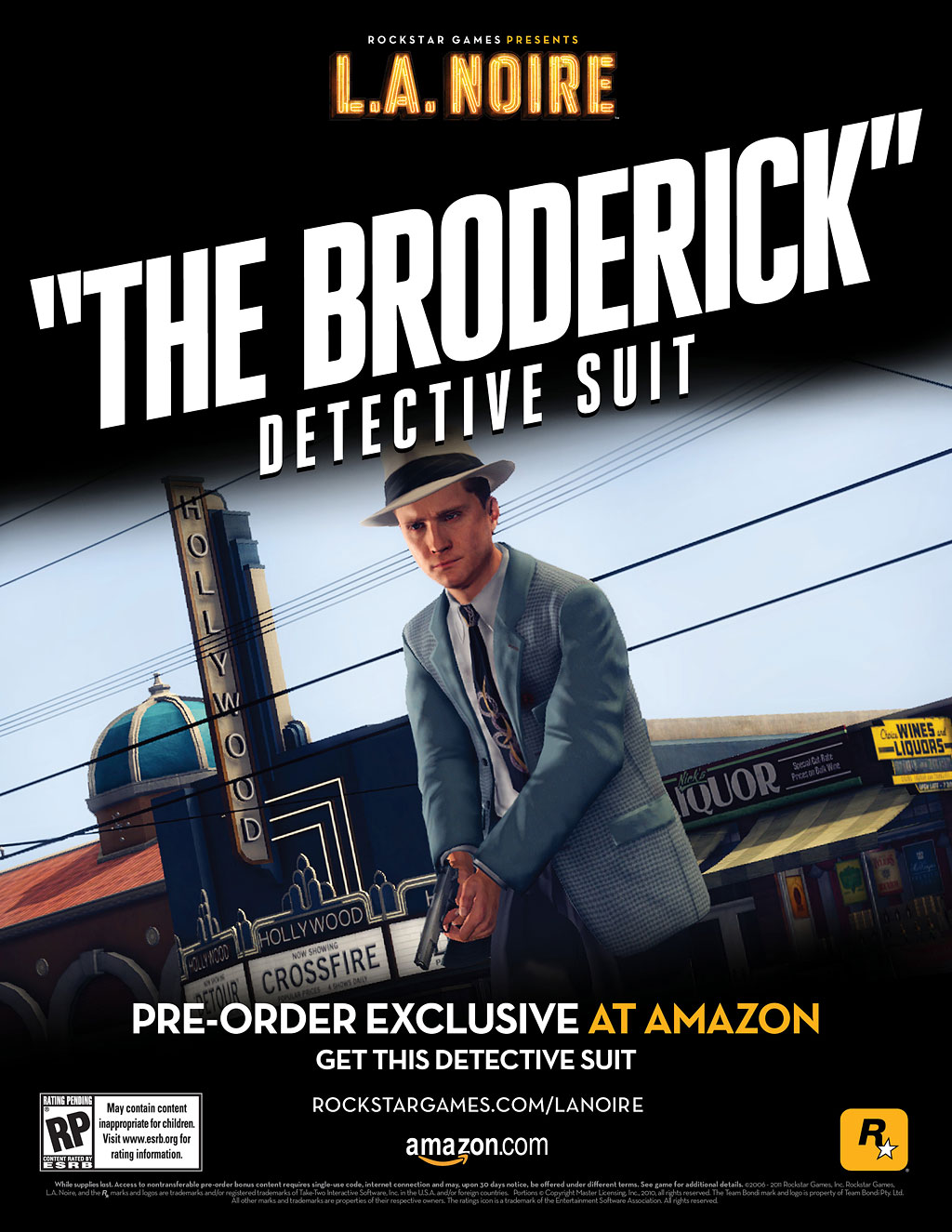Rockstar Games has revealed that there are multiple pre-order bonuses for L.A. Noire, from suits that enhance abilities to bonus missions. Check out the nifty “posters” made up for the announcement.




Source: RockstarGames.com
Rockstar Games has revealed that there are multiple pre-order bonuses for L.A. Noire, from suits that enhance abilities to bonus missions. Check out the nifty “posters” made up for the announcement.




Source: RockstarGames.com
Robert Rodriguez has made a name for himself with his flashy grindhouse films and Kobe Bryant is known for being one of the best finishers in the NBA. Combine both and you have some of the best production values in an ad you’ll see all year!
{video link marked “private”}
The first teaser trailer for The Elder Scrolls V: Skyrim got fans hyped up for the anticipated RPG, but they had to deal with the paucity of information that came with it. Worry no longer, Elder Scrolls fans, as this expanded trailer features magic, dragons and lots of other cool in-game stuff!
{video link no longer active}
Sometimes videos are aggressively edited in order to compress as many gameplay moments into as small a period of time as possible. The use of this tactic sometimes obscures the quality of a game, but in this case Battlefield 3 is looking quite impressive.
{video link no longer active}
Online games are increasingly becoming reactive to players wants and needs. That’s all well to say, but doing it means acquiring and processing a lot of data and not every company is immediately up for that task. GamesAnalytics is here to help with this growing issue, and we talked with Alan Miller, Director of North American Operations, about this new field in gaming.
Alan Miller: We provide technology for online game companies to help them increase revenue and player satisfaction. This is part of the change from brick and mortar to digital download, which I think is great for the industry, not so great for retailers! It has many ramifications – the monetization model was a one time purchase thing – that is something that has little relevance in many online games. It’s about purchases in games and that’s what GamesAnalytics does. We can predict where the players are going and provide them with handsome offers and challenges and move them away from frustrating situations. We offer a turn key solution that provides these services.
Alan Miller: That’s right! Part of it is behavioral analytics and applying that to development. Even if you collect the data some may wonder ‘What do you do with it ‘ You merge our experience with the analytics and we can take care of it. We have a novel approach – we do it in real time, knowing where players are and send them targeted messages based upon those metrics in the player’s game. Nobody closes the loop quite like that.
The way we deliver these notifications is through the in-game messaging system, so these notes are delivered in the context of the game, and we don’t deliver them ourselves, we send a message to the publisher. We have an agreement that these messages will be approved.
Alan Miller: In the past, I developed at least a 100 different games. I’ve been working in the industry since ’77. Our goal was to create a popular franchise and iterate it every 18 to 24 months at Activision and Accolade. The way it was with games originally, we tried to develop as much as possible and that was it. As time evolved, we sent in bug fixes and they got patched, but in the last few years we’ve been able to continue development after release. For online, now we’re looking to put out updates every 3 to 7 days. So the situation has changed now; they’re delivering unfinished games and it’s going to continue evolving as players play the game.
These changes are part of the reason I’m interested in GamesAnalytics and the ability to change and tweak things to help the player experience. In order to do it, they have to determine what players are doing that’s getting them frustrated. These are the sort of things human beings can’t figure out, so we need the analytics to find out what’s successful and deliver hints and challenges to move them in the right directions.
Publishers are usually interested in capitalizing on monetization. Part of the reality of online games, is that only 1-2 percent make payments! So most payments are voluntary; it’s making small incremental purchases for a decorative item or two. Zynga said they have 320 million unique individuals that have played their games, but their revenue rate is $750 million, so those millions of players have delivered only $2 per player, not good ARPU. So its important to recognize and motivate players towards payment.

Zynga’s success is in no small part from looking at the data.
Alan Miller: The online audience is very diverse. In retail distribution, you couldn’t get those games [you mentioned] on the shelf, so there’s a lot of diversity. What we provide is a turnkey procedure that’s simple to apply to the game. We look at a mirror of the data, and we send signals back to the game, to accomplish very specific things for specific gamers in specific games. For instance, the audience for MMOs is quite diverse, but they all have virtual goods. Virtual goods have come to dominate the industry; past year, 7.5 billion was spent on virtual goods and here it’s looking to be 2.1 billion in the U.S., so we’re still behind; a lot of that revenue occurs in Asia. But that’s just an example of how but you also have to look at where the revenue comes from in games.
Alan Miller: Generally, that’s correct. Any company that wants to compete has to respond to them. Zynga has the biggest analytics group in the biz and I think there’s a direct correlation between that and their success. They will probably exceed a billion in revenue this year. A lot of publishers can’t afford to staff up like that, but all online game publishers need those sort of stats, but they maybe can’t afford to invest in [it like] Zynga. And that’s where we come in!
Alan Miller: I’ve been exclusively working with online games for the past 10 years. Even online games originally started as a one time purchase; it was part of the evolution from retail. We’ve experimented in advertising supported, subscription, but now virtual goods are dominating. I don’t think it’s the end of the evolution, so there’s going to be continued experimentation models, but several subscription based games have changed their models to virtual goods and World of Warcraft is experimenting with virtual goods; they had a lot of success with it.
Alan Miller: There are a bunch of competitive reasons [to go F2P.] There a bunch of competitive free options. So when all your competitors are offering something and you don’t, it will eventually put pressure on them. Now some companies are experimenting with tiered subscriptions, so you can have different levels of commitment from consumers. But the guys of Blizzard are sharp and they know what they are doing, and at Activision they’re quite prescient in the evaluation of the product so kudos, but at the same time they’re learning that not all their properties are keeping up. Take purchases in the expensive peripheral market; when you see [that plastic guitar] next to the game box it’s an incentive… or was an incentive.
Alan Miller: A very real world example – you’re a subscription based MMO. You see a lot of people leaving after a certain point or level; you clearly don’t want them to abandon the game. [Our software] can analyze different behavior and find out why they no longer subscribe. We are getting close to that point where we can look at the analytics in real time. So we can send them a marketing message, like offering free goods to make them still interested in the game.
Since only 1 or 2 percent of players are paying [in F2P games], we can identify behaviors that led them to be paying players. So we look at that, and examine the non-paying players and push them towards being a paying player. These are all in context of the game as a marketing message. Like “talk to the innkeeper†or “here’s a sword to defeat the dragon.†We work with the publisher in advance and develop what is appropriate.
Alan Miller: The last thing we want to do is make a player alienated; we want to put the publisher on the right path. We only send the publisher info relevant to that.
Alan Miller: We do provide various compression streams, but in general, we look at the entire player database. It’s not live, it just sits in parallel and to what resides on the client’s servers. Our interface can respond with a very simple message. It’s very important that it be easily integrated; we call it turn key solution.
Alan Miller: Yes… in fact, all the traditional publishers are transitioning to online publishing and are gathering massive player data; a big game can collect a terabyte of data a day. Disney bought Playdom; EA bought Playfish. A lot of traditional publishers have difficulty making a go of it in the online sector on their own. We do need to have a large data set to make our analytics useful; Playdom and Playfish are in the top online games, so our analytics would work for all of their games.
Alan Miller: One thing I want to bring up is that many people think there’s going to be a lot of consolidation in the industry, and I don’t think so, because I think there’s going to be a lot of possibilities for publishers in targeting a specific audience. Because of the social grid of the internet, consumers are often quickly aware of a good game if it’s out there. In retail distribution, there’s only about 50 or so publishers; those constraints aren’t there when you’re talking about online.
You’ll probably see more companies providing these specific back end services; [Richard] Garriot provides some services for example. It’s complex to set up a game company, but luckily, they are becoming more affordable and GamesAnalytics help can provide the services you need.
_ _
What do you think of the analytics-driven approach to design? Join the conversation at Facebook!
Intel has revealed its Thunderbolt interconnect technology, which will allow for transfers of 10GB per second (enough to transfer a high-def movie from one source to another in under a minute). The technology will be exclusive to Apple for home consumption until 2012, with MacBook Pro computers being the first to offer it.
The technology was specifically meant for synching between computers and other devices (like sound systems and TVs), so audio and video enthusiasts will be thrilled with it. Thunderbolt could be a competitor to connector technologies such as USB, Firewire and HDMI; special Thunderbolt connectors and cables will be needed to connect devices along with a controller chip supplied by Intel.
Source: Computer World
Sony has announced that the voting for the PlayStation Network Gamers Choice Awards is now open. PSN users get one vote in four catergories: Best PS3 Downloadable Game, Best PSP Downloadable Game, Best PS3/PSP Mini, and Best PSN Exclusive Game.
The voting will end on March 1, with the winners being announced on March 7. Afterwards, the winners will be highlighted in the Spring Fever sale, where they’ll be available for a discount (an even larger discount for PlayStation Plus users).
Source: PlayStation Blog
New technologies are affecting how display advertising is working across the web. Google s VP of Product Management Neal Mohan argues that this has changed the digital buying marketplace and requires some new laws.
Mohan argues that when it comes down to a Demand Side Platform (DSP) or the Google Display Network, he makes a comparison to stocks. “Those wanting to be like an online broker and manage ads with their own technology and data should look into DSP, whereas if there is a desire to outsource the campaign for a desired result to a stockbroker the Google Display Network is probably a better choice.”
“He also argues that getting audience buying and contextual advertising is not a case of getting one or the other. We believe it s the combination of the two that is most powerful,” said Mohan. “Marketers combining these types of buying can reach a broad range of people, then hone their messages to particularly good prospects to maximize the impact of their campaigns. We ve seen that this approach drives better campaign performance; third party studies back it up.”
Mohan also says the industry is always moving. “The industry is literally moving faster as media buyers start to increase their use of real-time bidding (RTB) technology, which allows them to evaluate and bid on ad space on an impression-by-impression basis. We re seeing this rapid growth and change first-hand. Since we acquired Invite Media in June 2010, the number of advertisers on the platform has doubled; agency spend has grown by almost 300 percent. And spending on display ads on the Google Display Network is growing more than 100 percent annually in a large number of countries. Publishers are benefiting from these changes as well (for example, a recent study found that publishers who participated in the DoubleClick Ad Exchange see an average 188 percent revenue lift when the exchange wins the auction).”
“Unlike the Big Bang, the expansion in our industry is not chaotic or random. We re moving towards a single platform that seamlessly incorporates the best technologies for planning, buying, serving, creating and measuring display ads; one that will enable marketers to effectively reach and engage people across desktops, tablets, videos, mobile devices and TVs,” he concludes.
Source: AdWordsAgency.Blogspot.com
PlayStation Home is over two years old now, and the platform has evolved a lot from its roots as a PS3 virtual world to a platform for numerous free games. While Home didn’t necessarily make the great first impression on many, PlayStation Home s platform director Peter Edward says that PS3 users should give it another shot.
“I hear all the time I logged on when it first launched but there was nothing there but I urge people to go back on there,” said Edward. “It’s been two years. We were always very proud of what we had achieved for launch, but we’re the first to admit it was basic back then. Two years down the line it has come on in leaps and bounds, is vibrant, full of cool content and great games to play. It s free those who aren t going in there are really missing out. If you think Home is what it was two years ago, do yourself a favor and have another look, you won t be disappointed.”
He notes that a large part of the success with the game has to do with brands coming in and launching successful projects. “Take Audi, they worked with a third-party to create some games in Home. Users kept playing, and Audi has since put more games in. Actual, decent fun games,” details Edward. “Red Bull has seen the same results. What doesn t work is just creating a showroom but Home wasn t really about that in the first place, and the smarter companies get that.”
Source: Develop
Trion Worlds has announced that they have seen a million registered accounts for Rift. The fantasy RPG has been running in various beta tests for the past few months, exposing players to the breadth of its content.
Rift will be allowing pre-order customers full access to the game very soon ahead of its launch in North America on March 1 and in Europe on March 4. Read about the game’s online advertising campaign (which takes a shot at World of Warcraft) in a feature here.